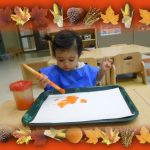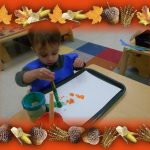Description and Learning Objectives
Painting is a popular activity within our curriculum. A variety of materials are offered to enhance the painting experience including brushes, sponges, or any other objects that can be incorporated into the activity. Through painting, children are able to practice and develop in areas such as sense of self, fine motor skills, cause and effect as well as sensory discrimination.
Materials
- paper
- variety of materials for painting (e.g. paint brushes, sponges)
- different coloured paints
Observations and Findings
Painting provides opportunities for children to practice their fine motor skills through the use of their hands and fingers to manipulate different objects. The children learn how to hold the objects and how to move these objects in order to apply paint to the paper (e.g. holding the paint brush with the bristles towards the paper). Painting also introduces the children to the concept of cause and effect. They learn and see first hand that brush strokes leave marks on the paper and the amount of pressure determines the amount of paint transfer. Children are also able to discover the concept of colour mixing, wherein mixing colours together makes a new colour. Also with the practice of labeling and recognizing different colours, the development of expressive language and visual discrimination skills is fostered.
Painting allows children to gain a sense of self and provides them with an outlet for their own creativity. They are able to gain a sense of achievement and confidence in independently creating something from start to finish. With the variery of materials provided, children are also able to explore and discover how to use these objects and what they are capable of producing with them. Painting with the under two community is mostly a messy process but it is truly a worthwhile endeavour because what the children accomplish and learn benefits their growth and development.



